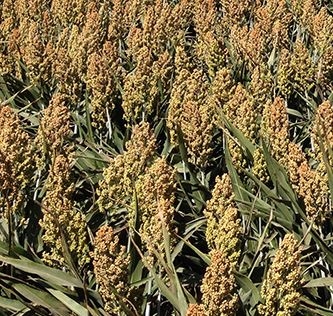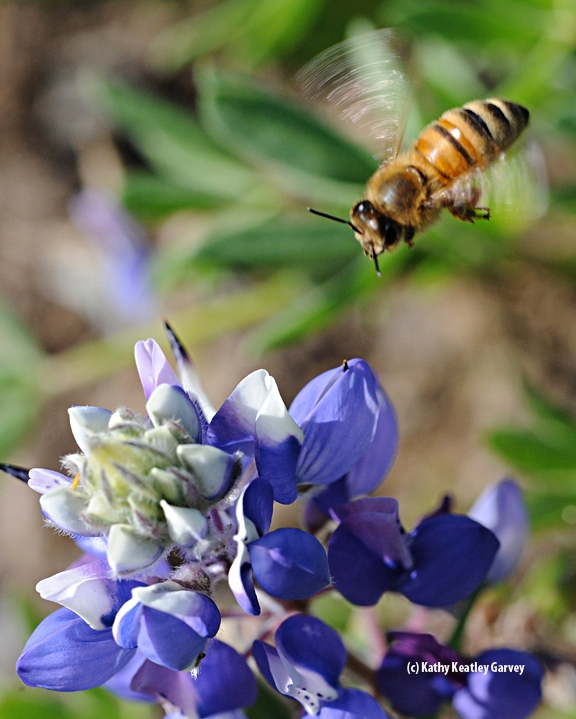Posts Tagged: forage
Sorghum research at the UC Agriculture and Natural Resources Research & Extension Centers available to the public.
If you are interested in getting information regarding research on the use of sorghum as a multi-purpose low-input crop for California, please go to this link. Under the research link, there are some videos showing the harvest of experimental plots as well as the use of a drone to perform rapid, robotic phenotyping of sorghum for character traits such as plant height, leaf area, and biomass area--data points used to help search for genes that control mechanisms involved in both drought tolerance and salinity tolerance in sorghum. Research is currently being performed at Kearney Agricultural Research and Extension Center, Desert Research and Extension Center, and West Side Research and Extension Center.

Photograph of sorghum plants.
Chinese delegation visits Kearney to learn about sorghum forage for dairies.
The U.S. Grains Council sponsored a team of managers from leading dairies in China to visit local dairy operations in California, discuss feed and nutrition issues, and to attend the World Dairy Expo in Chicago. The team, made up of nutritionists, farm managers, and general managers met with Jeff Dahlberg, Director of the Kearney Agricultural Research and Extension Center, and sorghum expert to discuss the potential use of sorghum forages and grain for dairy feed. Dahlberg spent several hours providing the delegation with a field tour and lecture on “what is sorghum” and its potential use as a low input, low water source for nutritious dairy feed. Dahlberg is investigating the potential of sorghum for dairies in California and information about its potential and evaluation of potential commercial sorghum forage hybrids can be found at sorghum.ucanr.edu.

Chinese delegation that visited Jeff Dahlberg's field research on the use of sorghum as a dairy forage.
Do You Have a Little Land to Spare for the Bee Buffer Project?
Do you have a little land to spare, such as a quarter of an acre or up to three acres? For honey...

Honey bee on a California golden poppy. (Photo by Kathy Keatley Garvey)

Honey bee heading for lupine. (Photo by Kathy Keatley Garvey)
Do Honey Bees Impact the Native Bees?
The European honey bee, also known as the Western honey bee, has been in the United States for...

A honey bee and a yellow-faced bumble bee sharing a purple coneflower, Echinacea purpurea. (Photo by Kathy Keatley Garvey)

Two's company: A honey bee and a yellow-faced bumble bee forage on Scabiosa. (Photo by Kathy Keatley Garvey)
Kearney’s 2013 alfalfa and forage meeting provides diverse tools to the agriculture community.
The recent alfalfa and forage meeting at Kearney attracted about 100 growers and pest control advisors.
Shannon Mueller, UC Cooperative Extension advisor and director in Fresno County, agronomy, alfalfa, hay, forage crops, honeybees, seed oil crops, and dry beans, indicated that grower knowledge of the local pest and disease pressure and selection of an alfalfa variety with desired resistance qualities is an effective IPM tool for managing pests and disease in alfalfa crops.
Dan Putnam, extension specialist in the Department of Plant Sciences at UC Davis, agronomy, alfalfa and forage crops, alternative field crops, cellulosic energy crops, crop ecology, shared that some of the nitrogen produced by alfalfa (a legume) remains and is available for subsequent crops. Current research has a goal of developing alfalfa’s nitrogen credit to help manage nitrogen fertilizer supplementation for non-legume rotational crops (like wheat). Putnam also shared the potential value of sorghum as a summer irrigated forage crop for dairy and livestock production that requires less water and nitrogen as compared to corn (California’s main forage crop). Research on the sorghum is ongoing, with benefits and limitations being identified.
Michelle Leinfelder-Miles, UC Cooperative Extension advisor in San Joaquin, Contra Costa, Sacramento, Solano and Yolo counties, crop production, soil and water quality, the Delta, discussed concerns and management strategies related to the co-existence of Roundup Ready (RR) alfalfa and conventional alfalfa. Gene flow between seed producing alfalfa fields has been observed. Gene flow between hay producing alfalfa fields is mainly prevented by management barriers, particularly the cutting of hay at a stage that minimizes any seed development. Best practices to allow growing and separating both RR and conventional alfalfa were discussed. Additionally, growers can use test strips that allow easy and quick detection al RR alfalfa if customers do not want any RR alfalfa.
Jeffery Dahlberg, director at Kearney Agricultural Research & Extension Center, plant breeding, agronomy, field crops, sorghum, plant production, plant genetics, discussed sorghum variety trials designed to assess many characteristics, including water use, fertility, forage quality and yield. Dahlberg indicated that sorghum serves as a grain and forage crop for livestock, and biofuel crop.
Robert Hutmacher, cooperative extension specialist and director at West Side Research & Extension Center, cotton production issues, water stress, nutrient management, indicated that water conservation is a high priority. Hutmacher highlighted water timing and reduction research that indicated that although yields are lowered with less water, acceptable sorghum crop yields can still be obtained. Yields of grain sorghum were impacted less than yields of forage sorghum with reduced water use.
Steven Wright, UC Cooperative Extension advisor in Tulare and Kings counties, cotton, small grains, weed control, discussed how nitrogen/wheat variety management strategies help maximize both yield and protein levels while minimizing ground water contamination in growing areas.
Larry Godfrey, UC Cooperative Extension Specialist in the Department of Entomology, UC Davis, entomology, discussed the Blue Alfalfa Aphid, which caused extensive economic damage throughout California last year. The Blue Alfalfa Aphid was a major problem in the 1970s, and a minor problem in the interim. The pest management materials that were effective historically were not effective last year. New pest management strategies have been developed and a new use registration and/or section 18 use permit are pending, hopefully in time for the 2014 alfalfa growing season.
Kurt Hembree, UC Cooperative Extension Specialist in Fresno County, weed management strategies in crop and non-crop settings, discussed weed management strategies for RR and conventional alfalfa stands. Hembree indicated that best practices are to design weed management strategies according to existing and anticipated weeds with extra weed control effort during early stand development. Hembree stressed that if growers want to preserve the benefits created by RR alfalfa, they need to reduce the chances of weed resistance to glyphosate with escapes control, mode of action rotation, and/or tank-mixing with other herbicides.
For more information, please look at the California Ag Today blog.

Forage and Alfalfa Day attendees visiting research plots at Kearney. (photo by P Cavanaugh)